Contents
- 1 INTEGRATED HUMAN PRACTICES
- 1.1 Our Project
- 1.2 Feedback
- 1.3 Interview with José Alfredo Gutiérrez Constantino, from PromaPlast
- 1.4 Advisory from Dr. Patricio Adrián Zapata Morín
- 1.5 Advisory from PhD. Mauricio Carillo-Tripp
- 1.6 Advisory from MsC. Miguel Loera
- 1.7 Advisory from Dr. María Mercedes Roca
- 1.8 Advisory from MSc. Joel Ediner Fuentes Campos
- 1.9 Changes We Made
- 2 HUMAN PRACTICES ACTIVITIES
- 3 Why we chose this approach?
- 4 How we engaged with our community?
- 5 Interview with Dr. Martha Guerrero Olazarán
- 6 Interview with Dr. Patricia Zambrano
- 7 Interview with Dr. María de Jesús
- 8 Potential Impact
- 9 References
INTEGRATED HUMAN PRACTICES
Our Project
The focus of our project is on the impact of the paper industry in Mexico, which is made up of small and large companies, both Mexican and foreign, mainly American [1]
In this industrial sector, a procedure known as Kraft Process is carried out to convert wood into pulp; which has a toxic byproduct known as Black Liquor (BL), which is a mixture of cellulose and lignin residues mainly, in addition to some inorganic chemicals.
BL is highly polluting due to its toxicity and, in addition, its stability makes it take many years to degrade, so it remains in the waters where it is discharged, causing chronic damage to ecosystems.[6]
To more clearly establish the impact of BL on an ecosystem, we made an Ishikawa diagram:
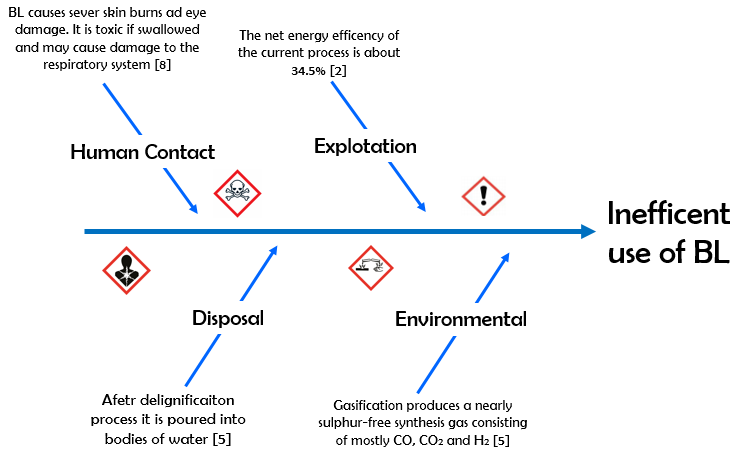
This diagram seeks to explain the main reasons why we consider the inefficient use of Black Liquor as a problem. Being that, it represents a risk for the workers who would be in contact with this substance. Once this substance goes through a process of "Delignification", it is discharged into bodies of water. The companies that produce this substance usually burns it for energy generation. However, this process is not as efficient compared to other forms of obtaining energy in addition to the environmental implications of its burning by the production of greenhouse gases such as Carbon Monoxide, Carbon Dioxide, Hydrogen, among others.
The process most commonly used to treat BL is gasification, which has some variants, such as the Black Liquor Gasification Combined Cycle (BLGCC). Another of the processes that are carried out is de-lignification, from which a mass with the requirements to be poured into rivers could be obtained.
The energy efficiency obtained when treating BL is very low concerning its optimum value, with which paper processing plants could produce the electricity they require [5].
Worldwide, the pulp and paper industry currently processes about 170 million tonnes of black liquor (measured as dry solids) per year, with a total energy content of about 2EJ (ExaJoules), making black liquor a very significant biomass source [4].
The process by which energy is usually obtained from BL is that of gasification, through which sulfur, CO2, CO and hydrogen gases are released, which are used as fuels [4].
Feedback
Interview with José Alfredo Gutiérrez Constantino, from PromaPlast
We had an interview through the phone with José Alfredo Gutiérrez Constantino, sales chief at PromaPlast, whom we contacted through different phone calls we made to companies related to our project (fossil fuel derivatives and precursors producers).
PromaPlast is an international plastic and chemical distributor. It can be found from México up to South America.
Due to confidentiality petition made, we can't make the interview public. The feedback we received helped modify our project the following way:
- We noticed the need to publicize green production methods, beyond the concept of production from recycled materials, which are traditional "sustainable" processes.
- We made a video of diffusion in which, we explain that the substitution of oil as raw material for many of the products of daily use is one of the most important steps to be carried out in favor of the environment.
Advisory from Dr. Patricio Adrián Zapata Morín
Dr. Patricio Adrián Zapata Morín has a degree in Genomic Biotechnology from the Autonomous University of Nuevo León. He studied Genomic Biotechnology, M.C. Engineering and Biomedical Physics, Doctor of Engineering and Biomedical Physics, and his areas of knowledge are: Biophysics, Data Science, Computational Biology and Genomics also he is the Doctor in charge of the Data Science department of the FCB UANL
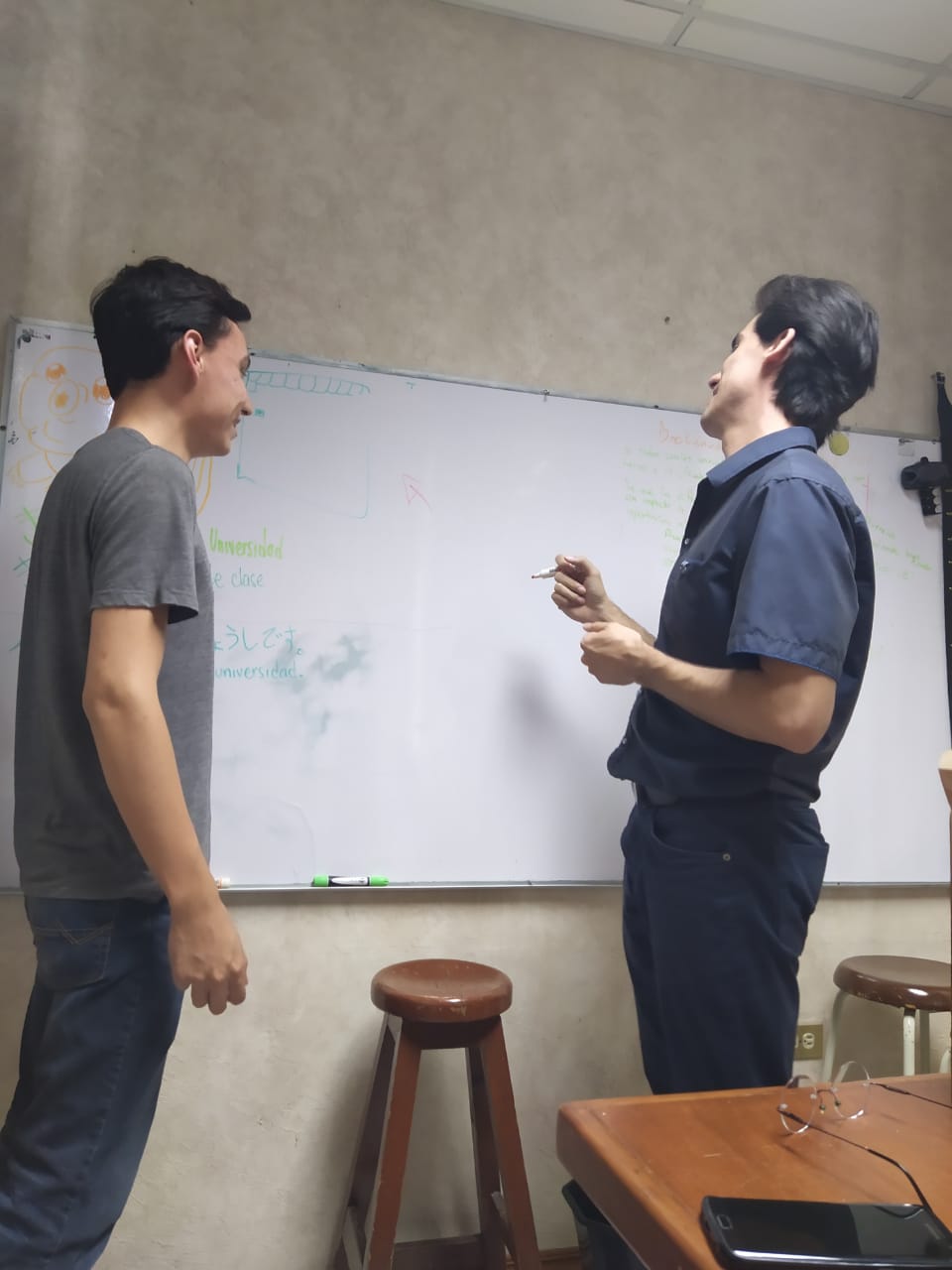

Due to his experience in the area of molecular dynamics, we asked for his advice to start the mathematical model; He guided and validated our ideas regarding how to verify the stability of the modified protein, the calculation of the diffusion of the substrate through the pore and the computer tools to be used for these purposes.
Advisory from PhD. Mauricio Carillo-Tripp
Mauricio Carrillo Tripp has a degree in Physics from the Autonomous University of Baja California (UABC), he has a doctorate in Biophysics from the Autonomous University of the State of Morelos (UAEM). He has completed three postdoctoral degrees, in Chemistry Department, Wabash College, USA 2005, Molecular Biology Department, The Scripps Research Institute, USA 2008, Applied Physics, Cinvestav Mérida, 2009.
His participation as an advisor was in the area of mathematical modelling, as he has experience in the field of high-performance biomolecular modelling and dynamics. Our contact with him came from the Development of next-generation antiviral drugs with the help of molecular biophysics and high-performance computing conference, in which he gave us feedback on the realization of the molecular simulations carried out.
From this, the leader of the simulation area of the physical model began working in his laboratory at the Center for Research and Advanced Studies (CINVESTAV) of the National Polytechnic Institute (IPN) in a scientific summer stay of the Mexican Academy of Science (AMC). There his cluster was used to run some molecular simulations, he also coached us for the use of a license of the supercomputer of the IPICYT of San Luis Potosí, which was obtained a month later.
Advisory from MsC. Miguel Loera
MsC. Miguel Loera is a PhD. student, at the Department of Environmental Systems Science We had a videoconference in order to ask him for advice in the area of math modeling; he helped us creating the model for analysis and prediction and delimiting it according to our needs. It is based on differential equations.
Advisory from Dr. María Mercedes Roca
She studied at Zamorano University, Honduras from 1997 - 2014. At Zamorano, She researched plant virology, diseases of tropical crops, contributing to regulatory issues and science communication for genetically modified crops and teaching and course design. She has a PhD in plant virology from UCL and Rothamsted Research (University of London), and a B.S. in microbiology from Kings College, London. She is currently the Executive Director with Consult MRS, (Multiple Risk Solutions) a consultancy company dedicated to risk analysis of biological organisms and biosafety.
She offered her time and experience by coaching us in the process of doing an extensive risk assessment on our project; mainly in the broader biocontainment measures, and also offered help from a legal perspective. She also helped to get familiar with the standardized procedures that should follow the development of our plan to achieve an appropriate level of safety for the environment and the people involved in the development of the project.
Advisory from MSc. Joel Ediner Fuentes Campos
MSc. Environmental Microbiology, BSc. Environmental Engineering. Areas of knowledge: Synthetic Biology, Gene Editing and Biotechnology Regulation.
He offered his knowledge in the area of biosafety to make improvements in the risk assessment of our project. He helped the safety team to polish specific aspects of the report, such as what were the particular things that should be stated to communicate that our organism is not dangerous, and how should we classify the organism in the base of its potential to do harm. In other words, he helped us to review the report that we started with PhD Maria Mercedes Roca, to make the technical aspects more friendly with non-expert audiences.
Changes We Made
One of the first things we had to change was our way to look for information. As explained above, we had some trouble obtaining data from companies, so we learned how to obtain these information and integrate everything we could collect to make a useful analysis.
Talking with experts was very important for our project, because we noticed how people perceive the topic of green processes and the impact of industry in pollution. When talking about paper industry, most people think of trees, and they do not really know that is not the most important thing; in response to this, we took actions to make people know how paper industry contributes to this problem and how our project could help the environment.
Simulations and math model were two areas where feedback took a great importance, since there were a lot of changes through time. All the support and advices we received affected the way we perceived our project and its approach and delimitations.
HUMAN PRACTICES ACTIVITIES
Why we chose this approach?
Pollution is a very important issue our city faces nowadays, therefore we wanted to focus our project to an important cause of this problem. As Nuevo Leon is a highly industrialized area, we searched for the most important and numerous industries. Finding that Paper producers were the principal industry in Nuevo León.
On a global scale, the activity of this industrial sector is concentrated in 100 companies, whose reported revenues were 357.6 billion dollars in 2013. Although Latin America represents only 6.7% of world paper production, two of The 100 leading companies are in Mexico: Kimberly-Clark México and Bio Pappel [1].
The states of Mexico that present a more significant contribution to Gross Value Added (VAB) are the State of Mexico and Nuevo León, the latter with a GVA of 6013.39 million pesos and an annual growth rate of 3.4% [1].
In 2016, at least 59 paper manufacturing and distribution plants were reported in Mexico, distributed in 20 states of the Mexican Republic, with a market value of USD 12,991 million annually [7].
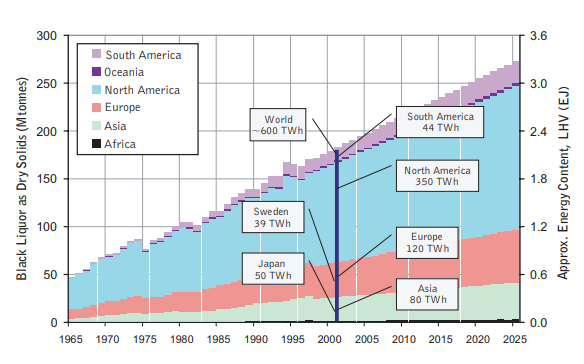
And that is why we wanted to engage with industries/companies regarding paper production.
On the other hand, we engaged with experts because they became our main source of information among with internet; this happened because companies did not want to share information about their processes with us.
Likewise, we engaged with young people through activities because one way or another, they will be the ones who forge the future, creating an impact in their lives can make a difference, and we know this first hand because some of our current team members were impacted by the activities performed by UANL iGEM team from 2014.
After noticing the lack of information regarding pollutants production, and the lack of interest from companies, with the help of ITESO´s iGEM team, we developed an interactive map, as a product of collaboration. In this map anyone can search for companies that produce different pollutants in the Metropolitan areas of Guadalajara and Monterrey.
How to use the map
On the left corner you can select the region and type of pollutant produced, once you have done that, you will see different circles, if you want to know certain company´s pollutants production just click on the corresponding circle, and the information regarding that company will appear. Besides, you will obtain more information, like location, type of company, etc. (IMPORTANT: Our team´s main information is stored in the "Black Liquor in Nuevo León" Section)
How we engaged with our community?
First of all, we identified paper producers as our main stakeholders, so we tried to contact them. Unfortunately, information about the environmental impact of those companies is not available, so we had to ask trough government transparency; we also tried to talk directly with them so we could interview them to know how they manage Black Liquor, but they apparently did not notice our attempts. (We sent emails, called them and even went in person, but some companies would just say “We will contact you”).
Thus, we decided to look for reported information about this issue, but then we had our next obstacle: there is not a study from Mexico. Then, we had to use everything we could find to make our analysis, using government information, environmental impact articles and scientific reports.
As we could not directly contact companies, we went to experts such as Doctors, and people who have been related to this industrial sector. We took their advices to change our project over time (you can find this information in our Integrated Human Practices section), and we noticed that the most important thing is the conception people have about how industrial processes impact the environment, and what can be made to decrease this impact.
Meanwhile, we started planning activities to raise awareness about this problem and by doing so we engaged with other stakeholders, in this case young people. The main activity we did to accomplish this goal was the “Túnel de la Biología Sintética” (TBS), information about this activity and how the use of this tool changed our project can be found at the Education Section.
Women in Science
Another problem we noticed while developing our project was the notable difference between Men and Women participation in Science.
The gender statistics provided by the iGEM Diversity Committee show an essential difference between men and women in 2013. The Paris Bettencourt iGEM team obtained this data, and they found that women were under-represented, especially on senior categories.
We found this data was an important starting point to take action and solve this problem. Just five years later, in 2018, statistics showed a significant advance, since women participation increased, having almost a 50/50 proportion. On the other hand, statistics of iGEM UANL team do not show this increase., we obtained the statistics from 2011 to 2014, and 2019 (editions we have participated).
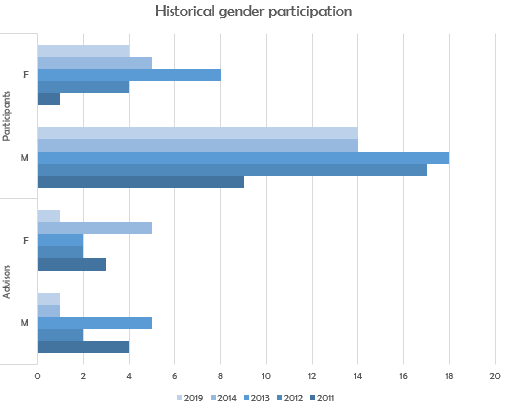
We took the example previously shown as an inspiration of how important it is to raise awareness about the problem to start solving it, so we did an action plan. First of all, we did some interviews.
Interviews for Women in Science
Interview with Dr. Martha Guerrero Olazarán
Doctor Martha Guerrero Olazarán is a teacher and researcher at the Facultad de Ciencias Biologicas of the UANL. Since she was in high school, she was interested in areas such as physics, chemistry and biology. The degree she studied was in Chemical Sciences by Tecnológico de Monterrey; however, When we asked about the obstacles that she had faced over the years, she stated that she would have liked to study biochemistry, but this career was in another city, so her family did not allow her to go because she was a woman.
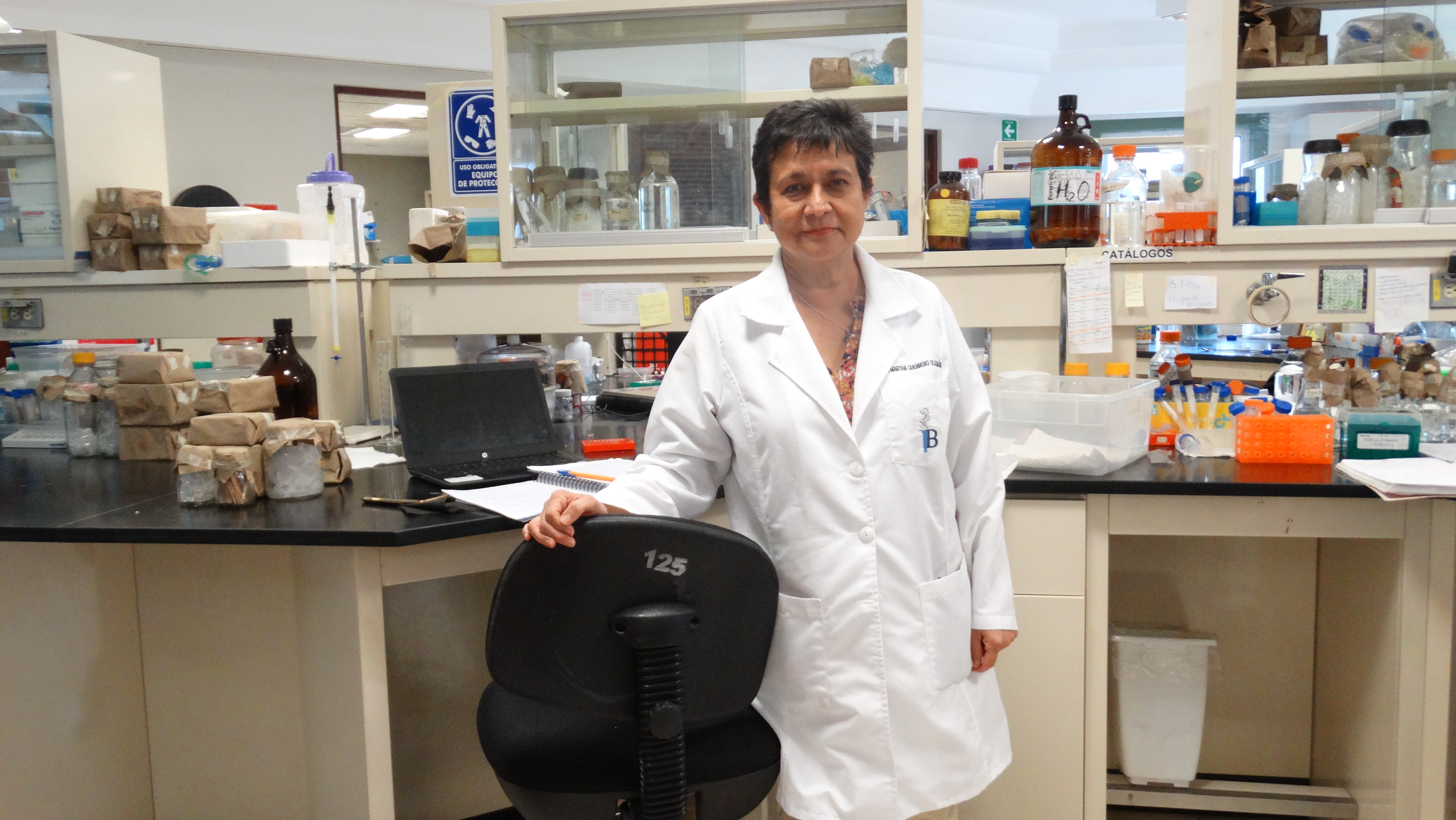
Also, she said that "women do the work to carry out day-to-day life, while men are the ones in decision-making," referring to the fact that inequality is in strategic decision-making positions. From her point of view, education with a sense of responsibility is essential for people to grow with the interest of generating a good for the community, so it is necessary to instil in children's social and ecological awareness and curiosity. So that more and more women can get involved in high-impact research projects, and achieve positions where they can make decisions that help society.
“Doing science is always studying and answering questions," Dr Martha Guerrero (2019)
Interview with Dr. Patricia Zambrano
The Doctor Patricia Zambrano is the director of research investigation in the UANL; she is a Mechanical Engineer Administrator then she made masters and a doctorate degree in Materials Engineering. Her work focuses on processes of manufacture and materials, and she also has several lines of investigation applied in methods of production. She now is involved in teaching and research, linked with the automotive mechanics of the region.
According to her experience, Dr Zambrano mentioned that there has always been a social prejudice where STEM careers are traditionally for men. This is why not many girls are interested in being involved in this area. That is why she started organizing a program called Mujeres en la Ciencia (Women in Science) in 2013, where women of these areas of study are the exhibitors and are looking to encourage more women to study STEM careers.
She states that the most important thing is to empower girls in a vital stage of their development, making them believe that it is possible, this way they will grow having aspirations and goals to reach. One of the primordial steps is High School because they find themselves in a key moment for their decision about studying or not a career, which is directly linked to what they want to do with their lives. Mujeres en la Ciencia (Women in Science) program intends to demonstrate these young girls who to look up to, examples of regular women who have been able to develop themselves on this kind of careers, ending with all existing stereotypes about why women shouldn't study science or engineering.
Even though many obstacles can appear, doctor Patricia Zambrano shows great optimism towards guiding young girls into believing that they can make their dreams come true, especially if it is a career. She also congratulated our team iGEM UANL 2019, because for her the Synthetic Biology Tunnel is a new and surprising activity, which wants to teach kids topics that not all know about and hopes this type of activities encourage more people to choose education over stereotypes.
Interview with Dr. María de Jesús
Dr María de Jesús Loera Arias is a Chemical Bacteriologist Parasitologist by the UANL, subsequently completed a doctorate in morphology at the faculty of medicine at the same university. She is currently a research professor in the same faculty.
Dr Loera comments that in her generation, there were more women than men studying. However, few continued with studies after the degree. One of the leading causes she mentions is that careers that involve research make it difficult to organize personal and work life since it is very demanding and hardly adaptable to a fixed schedule.
Throughout her career, she has not encountered obstacles related to gender discrimination if she has noticed that there is inequality as to who is in the management positions. Because even though she increased female participation in these areas, there is still less representation by the female gender, so she propose involve girls in programs of science, and educate new generations to leave stereotypes in the past.
With all the information and feedback we had, we propose the following:
- Get a space in Women in Science for the iGEM team, so more women will know the competition and will be interested in what we are doing
- Get involved in events organized by CONCIENCIA UANL, an organism that organizes science workshops for children, and hold something related to STEM education for girls
Potential Impact
The search for more sustainable methods of treating and taking advantage of BL is an urgent need nowadays, for both environmental and economic reasons, so we could migrate from a linear to a circular economy, and venture into alternatives to fossil fuels to produce derivatives of these.
When using black liquor (or biomass in general), this type of facility is often called a biorefinery. [5] In the case our project succeed, we would impact directly biorefineries; by completely changing the way industries manage Black Liquor. Nonetheless the impact over environment would be considerably big, since we will be decreasing the production of greenhouse effect gases.
References
[1] CONAFOR: Comisión Nacional Forestal. (2015). Perspectivas sectoriales de la industria de la madera y el papel. Sistema de Información Regional de México, S.A. de C.V.
[2] Darmawan, A., Hardi, F., Yoshikawa, Y., Aziz, M. & Tokimatsu, K. (2017). Electricity production from Black Liquor: a novel integrated system. Energy Procedia. Vol. 142. pp. 23-28. https://www.sciencedirect.com/science/article/pii/S1876610217357326
[3] DIF: Sistema Nacional para el Desarrollo Integral de la Familia. (2018). Manual de Lengua de Señas Mexicana. Gobierno del Estado de Puebla. http://dif.pueblacapital.gob.mx/images/descargas/MANUAL_LSM_Interactivo5.pdf
[4] IEA. (2013). Black liquor gasification; Summary and conclusions from the IEA Bioenergy ExCo54 Workshop. IEA Bioenergy. https://www.ieabioenergy.com/wp-content/uploads/2013/10/Black-Liquor-Gasification-summary-and-conclusions1.pdf
[5] NETL: National Energy Technology Laboratory. (SF). Black liquor gasification. https://www.netl.doe.gov/research/Coal/energy-systems/gasification/gasifipedia/blackliquor
[6] Ortiz Rivera, A.L. (2009). Tratamiento por acidificación controlada del licor negro derivado del bagazo de caña para la recuperación de lignina y la reducción de la demanda química de oxígeno. Universidad Tecnológica de Pereira, Facultad de Ciencias Ambientales, Maestría en Ecotecnología.
[7] Seale & Associates. (2017).Reporte de la industria del papel. Washington, D.C., Ciudad de México, Monterrey. http://mnamexico.com/wp-content/uploads/2017/05/Industria-Papel-4.pdf
[8]WestRock. (2015). Black Liquor. Safety Data Sheet. https://www.westrock.com/-/media/pdf/safety-data-sheets/wr0011black-liquor.pdf?la=en
